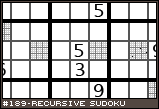| Three Hundred |
| - Index Page |
| - About... |
| - By Year |
| Collections |
| - Comp-Grid |
| - Procedural |
| - Tactics |
| - Tiny Crawl |
| - Misc |
| Previous | Mechanic #189 | Next |
![[sudoku1.png]](set10/img/entry189-sudoku1.png)
This is really for people who like Sudoku. You begin with an empty Sudoku board. Kind of impossible to solve, right? Well, you can click on a cell to be taken to another Sudoku board inside it.
![[sudoku2.png]](set10/img/entry189-sudoku2.png)
If you solve this Sudoku board, you will find out what number goes in its cell. However, the first level in only has a few hints filled in. If you want to solve this board, you'll need to go deeper!
![[sudoku3.png]](set10/img/entry189-sudoku3.png)
Each level deeper you go, the puzzles get easier to solve, either by having more numbers pre-filled in or by having puzzles which require less skill to solve. Of course, there are potentially thousands of Sudoku puzzles that need to be solved to fill in the squares of the root board. Luckily, it's still Sudoku, meaning you can still solve the puzzle through simple logic. A large part of the game is knowing which squares to solve for and which ones to go deeper on. One could even score the game based on how many puzzles needed to be solved. One way to make the game a little easier is that you could make a specific square on the child board be the correct answer. So if you click on square 6, subsquare 4, then the answer to that square in the child board would be 6,4 itself. That way, instead of having to solve the entire child Sudoku puzzle, you would only need to solve it far enough to get that specific square.
![[tictac1.png]](set10/img/entry189-tictac1.png)
Here is Tic Tac Toe. The difference is, after you've placed your X or O, your opponent can challenge it. This caused the cell to be a Tic Tac Toe board itself, with your X or O being the first item placed. For instance, if you put an X in the top right corner and the O player challenges it, it turns into a mini Tic Tac Toe board with the top left corner having an X in it. When it is your turn to place an X or O, you can place it in any available slot on any available board. If you win the board, you win the square. There should probably be a limit to the recursion. Maybe three levels deep. In a worst case scenario, both players challenge every piece placed down, leading to a whopping 81 Tic Tac Toe boards.
- This was NOT based on this xkcd strip. At least, not directly. Who knows how subconscious influences work? I started with the idea of modifying a Sudoku board somehow. I was initially concerned with those situations where you knew a number could be either at X or Y, thinking that there could be some case where you could answer that. Maybe something like placing markers outside rows or columns or something. That was going nowhere until I realized that you could play an easier Sudoku puzzle inside the cell to "unlock" it. Only after coming to that conclusion did I remember that xkcd strip - and the Recursive Tic-Tac-Toe idea IS based on it.
|
